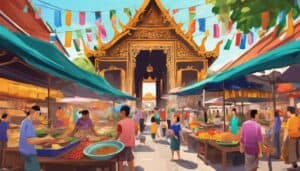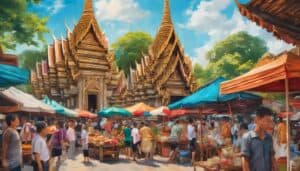The lotus, a symbol of purity and rebirth, blooms in the waters of Siam, inviting you to explore the depths of its rich history and culture. As you trace the footsteps of ancient traders and royal dynasties, you'll uncover the layers that define this vibrant kingdom. From the intricacies of its traditions to the grandeur of its architectural wonders, each aspect tells a story waiting to be unearthed. What hidden gems lie within its festivals and celebrations, poised to reveal the heart of Siam?
Key Takeaways
- The Kingdom of Siam's identity evolved through a blend of indigenous traditions and influences from neighboring civilizations over a millennium.
- Major royal dynasties, including Ayutthaya and Chakri, shaped Siam's cultural landscape and governance, fostering arts and education.
- Modern Thai monarchy reflects adaptation to social changes, transitioning from absolute rule to constitutional governance since the 1932 revolution.
- Festivals like Loy Krathong and Songkran embody community spirit and cultural values, celebrating traditions and social cohesion.
- Temples and architectural wonders showcase Siam's spiritual heritage, featuring intricate designs and vibrant murals that narrate cultural stories.
The Origins of Siam
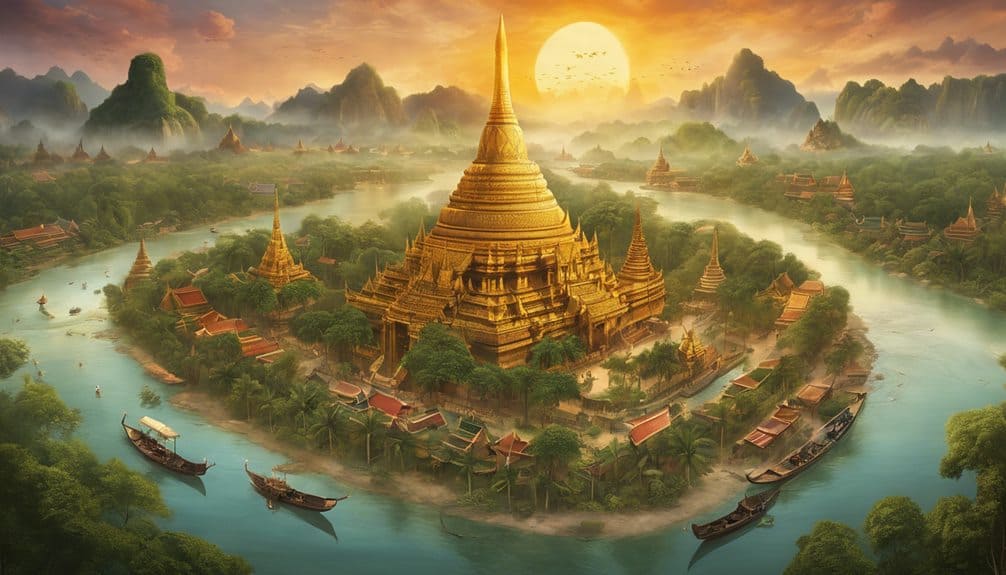
The origins of Siam can be traced back over a millennium, as various kingdoms and cultures intertwined to shape its rich history. You might find it fascinating how ancient settlements sprang up in the fertile river valleys, becoming hubs for trade and interaction.
These early communities didn't just exist in isolation; they were dynamic, engaging in cultural exchanges that influenced everything from language to religion.
As you explore this history, consider the role of geography. The region's rivers and mountains provided both barriers and pathways, facilitating the movement of people and ideas. Merchants and travelers brought with them not just goods, but also beliefs and customs, creating a tapestry of cultural influences.
The blending of indigenous traditions with those of neighboring civilizations led to a unique Siamese identity that would evolve over the centuries.
You'll notice that these interactions laid the groundwork for what would eventually become a powerful kingdom. This cultural mosaic reflects a time when adaptability and collaboration were key to survival and growth.
Understanding these origins helps you appreciate how the Kingdom of Siam emerged as a vibrant center of culture and commerce, resilient in the face of change.
Historical Milestones
Throughout the centuries, significant historical milestones have shaped the Kingdom of Siam, each one marking a turning point that influenced its trajectory. From the flourishing of Siamese trade to the preservation of ancient texts, these events not only reflect the kingdom's rich heritage but also its adaptability in the face of change.
- The establishment of trade routes in the 13th century opened Siam to vibrant exchanges with China, India, and beyond, enriching its culture and economy.
- The discovery of ancient texts in the Ayutthaya period revealed insights into Siamese beliefs, governance, and daily life, fostering a deeper understanding of its people.
- The signing of the Bowring Treaty in 1855 marked a pivotal moment, propelling Siam into the modern world by redefining its international relations and market practices.
These milestones highlight how the Kingdom of Siam navigated challenges and embraced opportunities. They show not just a timeline of events, but a narrative of resilience and growth.
As you explore the kingdom's past, you'll find that each milestone is a thread woven into the rich tapestry of Siamese identity.
Royal Dynasties and Influence
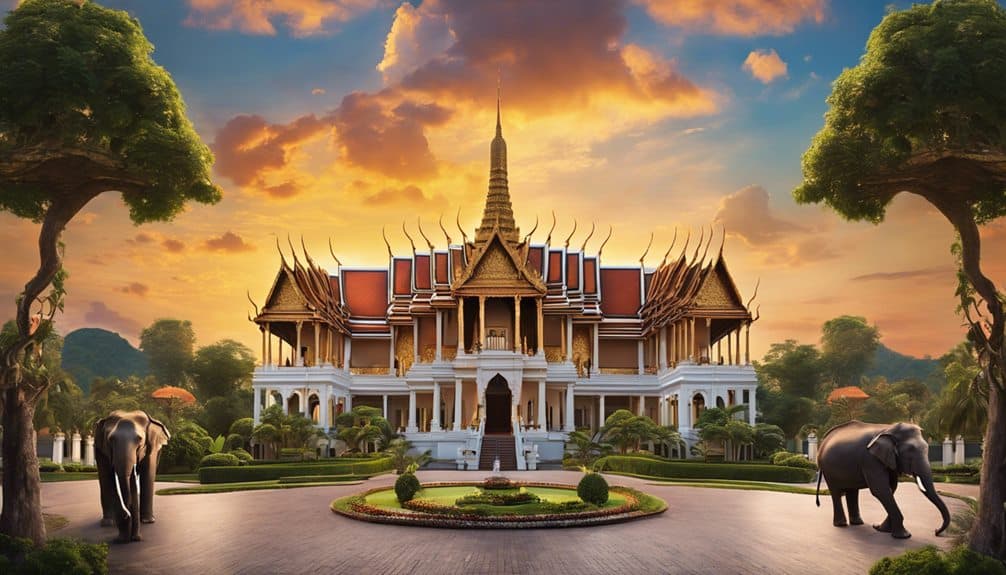
As you explore the royal dynasties of the Kingdom of Siam, you'll notice how each ruling family shaped the cultural landscape and governance of the nation.
The influence of these monarchs extends far beyond mere politics, impacting art, religion, and societal values.
Understanding this evolution of the monarchy will reveal how the modern Thai monarchy has emerged, reflecting both tradition and contemporary challenges.
Major Royal Dynasties
In examining the Kingdom of Siam, one can't overlook the profound influence exerted by its major royal dynasties, each shaping the nation's identity and governance.
The Ayutthaya Kingdom established a powerful foundation, fostering trade and culture that resonated through the ages. The Sukhothai Era introduced regal traditions and philosophies that emphasized the benevolence of historical rulers, laying the groundwork for future monarchial influence.
The Chakri Dynasty, which reigns to this day, embodies the continuity of dynastic legacies that link past and present. Through royal patronage, these dynasties have nurtured the arts, religion, and education, creating a rich cultural tapestry.
Consider these pivotal moments:
- The establishment of the Ayutthaya Kingdom, which marked Thailand's rise as a regional power.
- The Sukhothai Era's emphasis on moral governance, inspiring future generations.
- The Chakri Dynasty's modernization efforts, which transformed Siam into a contemporary nation.
Each dynasty not only governed but also imbued the people with a sense of pride and identity, illustrating how royal legacies shape the very essence of Siamese culture.
Cultural Impact of Kings
The profound cultural impact of Siam's kings extends far beyond their political reigns, weaving into the very fabric of national identity and societal values. Monarchic symbolism permeates daily life, where royal imagery and rituals symbolize unity and continuity.
You'll notice this in the intricate details of traditional Thai architecture and art, which celebrate the divine right of kings, embodying the belief that monarchs are the stewards of the nation's soul.
Royal patronage has played a significant role in preserving and promoting cultural heritage, enabling the flourishing of Buddhism, arts, and education. Kings have historically supported temples, artists, and scholars, fostering a cultural renaissance that remains influential today.
For instance, the reign of King Rama V saw significant modernization efforts that integrated Western influences while maintaining Thai identity.
As you explore this rich backdrop, it's clear how the kings' influence shaped the collective consciousness of the Thai people. Their legacies aren't just etched in history but continue to resonate through festivals, traditions, and the ongoing reverence for the royal family.
You'll find that understanding this cultural impact provides a deeper appreciation for Siam's enduring heritage.
Modern Monarchy Evolution
Evolution of the modern Thai monarchy illustrates a fascinating interplay of tradition and adaptation. You can see how monarchy reforms have shaped the royal landscape, particularly in the face of changing societal expectations. The balance between preserving historical legacies and embracing contemporary values is delicate but essential.
Consider these pivotal moments in the monarchy's evolution:
- The 1932 revolution that shifted Thailand from an absolute to a constitutional monarchy, redefining royal authority.
- The 1974 reform that allowed for greater public participation in politics, illustrating the monarchy's willingness to evolve.
- The recent royal succession with King Maha Vajiralongkorn, highlighting the ongoing relevance of royal influence in modern Thai society.
As you investigate these events, you'll notice how they reflect broader societal shifts. The monarchy's ability to adapt while maintaining its historical significance underscores its importance in Thailand's identity.
Each reform and succession carries weight, shaping not only the monarchy's role but also the future of the nation. This dynamic relationship between tradition and modernity continues to resonate, inviting you to explore the depths of its impact further.
Cultural Heritage and Traditions
Cultural heritage and traditions in the Kingdom of Siam reflect a rich tapestry woven from centuries of history, beliefs, and practices. As you explore this vibrant culture, you'll encounter a remarkable cuisine diversity that tantalizes the taste buds. The artistic expressions found in regional crafts showcase the skills passed down through generations, while traditional attire adds a colorful dimension to daily life.
Folk performances, rich in storytelling and music, illustrate the spiritual practices that bind communities together. Language preservation plays an essential role in maintaining identity, ensuring that stories and traditions are not lost to time.
Here's a visual representation of these cultural elements:
| Cultural Element | Description |
|---|---|
| Cuisine Diversity | A fusion of flavors and techniques from various regions |
| Artistic Expressions | Crafts, paintings, and sculptures reflecting local heritage |
| Traditional Attire | Clothing styles that signify cultural identity |
| Folk Performances | Dance and music that narrate historical tales |
Temples and Architectural Wonders
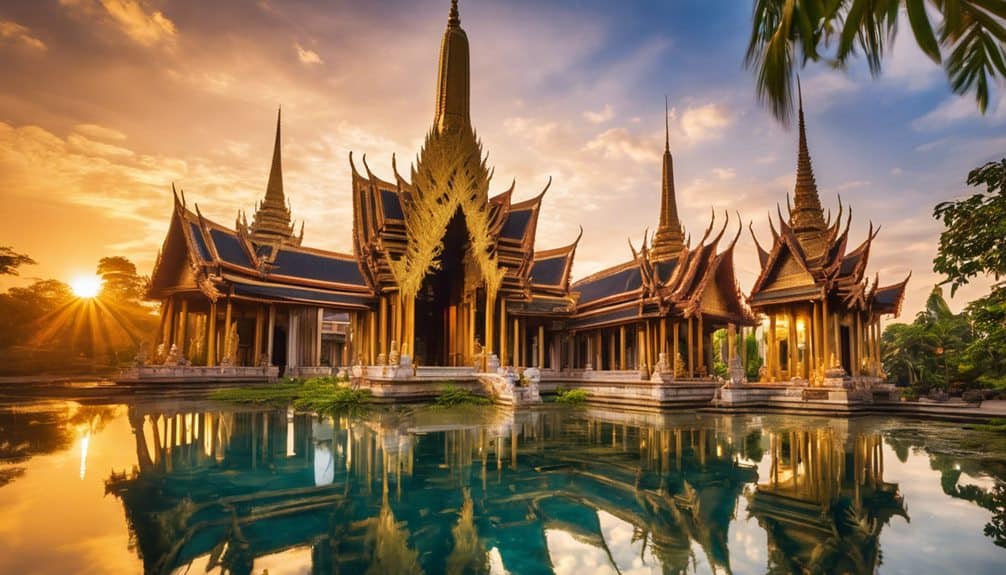
Nestled within the vibrant landscape of the Kingdom of Siam, temples and architectural wonders stand as living symbols to the region's spiritual and artistic heritage.
You'll find that temple architecture here not only showcases intricate designs but also embodies deep spiritual symbolism, offering a glimpse into the beliefs and values of its people.
As you explore these magnificent sites, consider the following emotional experiences:
- Majestic Spires: The towering chedis inspire awe, reaching toward the heavens and inviting contemplation.
- Vibrant Murals: Richly painted walls tell stories of ancient legends, immersing you in the cultural tapestry of the kingdom.
- Serene Courtyards: These tranquil spaces invite reflection, allowing you to connect with the spiritual essence of the surroundings.
Each temple serves as a testament to the craftsmanship and devotion of artisans who dedicated their lives to creating these masterpieces.
You'll notice how the unique fusion of local and religious influences shapes these architectural wonders, making them not just structures but sacred spaces.
As you stand before them, you'll feel the pulse of history and spirituality intertwine, reminding you of the enduring legacy of the Kingdom of Siam.
Festivals and Celebrations
As you explore the vibrant festivals of the Kingdom of Siam, you'll notice how each celebration reflects the rich tapestry of Thai culture.
These traditional events aren't just moments of joy; they carry deep cultural significance that connects the past with the present.
Understanding the essence of these celebrations offers you a clearer perspective on the values and beliefs that shape Thai society.
Traditional Thai Festivals
Celebration permeates the vibrant tapestry of Thai culture, with traditional festivals serving as a vital expression of community and spirituality. Each festival offers a unique glimpse into the heart of Thai life, allowing you to connect with the culture on a deeper level.
- Loy Krathong traditions: As you float your krathong on the water, you release your worries and pay homage to the goddess of water, creating a moment of reflection and gratitude.
- Songkran water: The exuberant water fights during Songkran symbolize purification and renewal. You can't help but feel the joy as you splash and engage with friends and family.
- Vegetarian festival: This festival encourages you to explore a plant-based diet, promoting health and spirituality while celebrating the harmony of body and mind.
The Candle festival takes you to the heart of Buddhist devotion, where intricately carved candles illuminate the night, showcasing the artistry and dedication of the Thai people.
Each of these festivals not only entertains but also invites you to partake in a rich cultural narrative, blending spirituality, community, and tradition in the Kingdom of Siam.
Cultural Significance of Celebrations
Festivals in the Kingdom of Siam serve as a mirror reflecting the cultural values and social dynamics of Thai society. Each celebration is steeped in meaning, showcasing the rich tapestry of cultural symbols that define the nation.
When you participate in these festivities, you're not just a spectator; you're engaging in time-honored celebration rituals that honor traditions passed down through generations.
Take Songkran, for instance, the Thai New Year, where water symbolizes purification and renewal. As you splash water, you're actively participating in a ritual that reinforces communal bonds and spiritual cleansing.
Similarly, Loy Krathong invites you to release floating lanterns, symbolizing the letting go of past grievances and welcoming new beginnings.
These festivals aren't mere entertainment; they're an essential expression of identity. They weave together history, spirituality, and social cohesion, allowing you to connect with the broader community.
Frequently Asked Questions
What Languages Are Spoken in Modern Thailand?
In modern Thailand, you'll find Thai as the primary language, enriched by various Thai dialects. Language evolution reflects the country's diverse culture, showcasing influences from neighboring regions and highlighting the dynamic nature of communication today.
What Is the Climate Like in Thailand Year-Round?
Thailand's climate's like a never-ending summer, with tropical weather dominating year-round. You'll experience hot spells, and during monsoon seasons, heavy rains sweep through, transforming the landscape into a lush paradise, teeming with vibrant life.
How Do I Travel Within Thailand?
To travel within Thailand, you'll find public transportation options like buses and trains convenient. Utilize travel apps for schedules and routes, making your journey smoother and allowing you to explore the vibrant culture with ease.
What Are Some Traditional Thai Dishes to Try?
Did you know Thai cuisine features over 1,000 unique dishes? You've got to try spicy curries like green curry and indulge in vibrant street food, including pad Thai and som tam, for an unforgettable culinary experience.
Are There Any Local Customs Tourists Should Be Aware Of?
When visiting Thailand, you should respect Thai etiquette, like removing shoes before entering homes. Attend cultural festivals to immerse yourself in traditions, fostering connections with locals and enhancing your understanding of the vibrant Thai culture.
Conclusion
As you explore the Kingdom of Siam, you'll uncover a tapestry woven from ancient trade routes and royal legacies, much like finding a hidden gem in a modern marketplace. The rich cultural heritage, from vibrant festivals to stunning temples, reflects a unique identity shaped by centuries of exchange. Embracing both the past and the present, Siam invites you to appreciate its journey, reminding you that history is not just about what was, but how it continues to resonate today.



